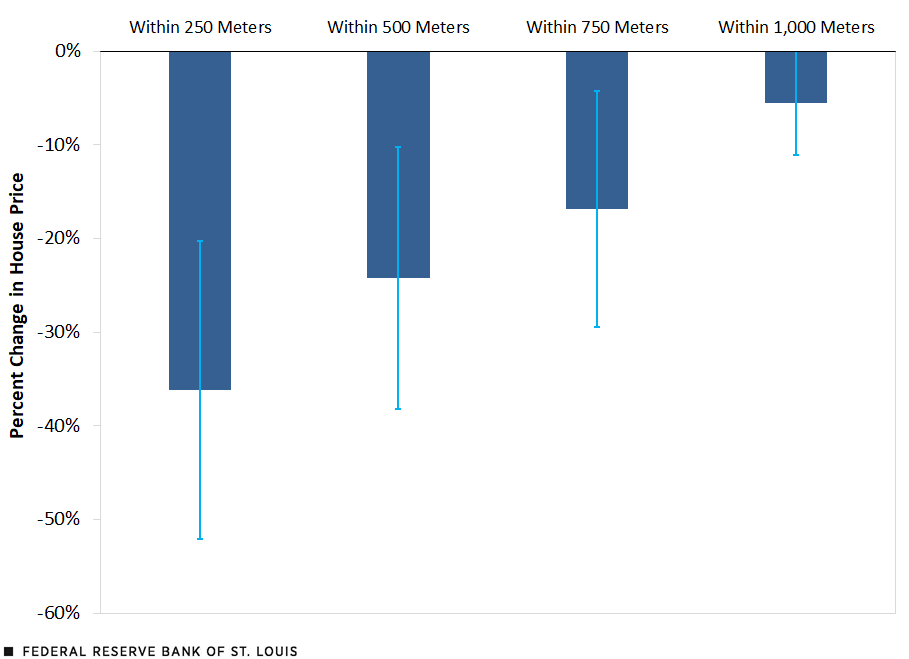Home Values after a Tornado: What Can St. Louis Learn from Little Rock’s 2023 Experience?
On May 16, 2025, a major tornado touched down in the St. Louis metro area, creating a path of destruction through St. Louis County, St. Louis city and communities in southern Illinois. Lives were lost, and thousands of buildings—including houses, businesses and churches—were damaged or destroyed by high winds, downed power lines and uprooted trees. The dollar valuation of damages has been estimated to be around $1.6 billion in St. Louis city alone.
The destruction hit neighborhoods across the socioeconomic spectrum, from Clayton, where the median house price exceeds $780,000 in certain neighborhoods, to north St. Louis city, where the median house price is less than $100,000 in some neighborhoods. This has left many people, regardless of income, with costly damage.
A 2025 working paper by Jeffrey P. Cohen and Violeta Gutkowski focused on one aspect of a recent natural disaster: It examined how home prices were affected by the tornado that struck Little Rock, Ark., in March 2023.See “Natural Disasters and Real Asset Prices: What Can We Learn from Tornados?,” Federal Reserve Bank of St. Louis Working Paper 2025-001A, January 2025. This blog post discusses their findings from the Little Rock tornado, which can provide a framework to understand the potential effects in the St. Louis area given relatively similar levels in median income and in housing value.The median house value in census tracts in the path of the tornado ranged from $85,000 to $661,100 in Little Rock and $92,500 to $785,000 in the St. Louis area. Data are derived from these Census Bureau tables for St. Louis County and St. Louis city.
Cohen and Gutkowski’s research suggested property values declined in the Little Rock neighborhoods hit by the tornado, but this effect was short lived. Specifically, the paper found that in Little Rock, the price of undamaged homes near damaged properties fell in the tornado’s aftermath, though the effect lasted less than a year. The focus on undamaged homes is to gauge the spillover effects of a tornado and to show how a natural disaster can affect not only the owners of damaged property but the entire community.
The authors also found that values of undamaged houses in low-income neighborhoods didn’t experience a sharper decline than those in wealthier neighborhoods. However, displaced lower-income families may have experienced a more prolonged negative impact than higher-income families because of the lack of immediate resources to pay for repairs, as higher-income neighborhoods in Little Rock saw more building permits filed in the first month after the tornado than low-income neighborhoods.
Proximity to and Number of Damaged Properties Can Affect the Value of Undamaged Homes
In their 2025 working paper, Cohen and Gutkowski estimated that undamaged houses within 250 meters (0.16 miles) of a damaged property saw, in the short term, an average decrease in sales price of 36% after the tornado. If multiple properties were damaged in a 250-meter radius of a particular undamaged house, that home’s average price declined 39%.
These effects dissipated with greater distance from the nearest damaged property. When the radius around an undamaged house was expanded to 500 meters (0.3 miles), the average price decrease was 24%, and when controlling for multiple damaged properties, the average effect was a 25% price decrease. As the distance became even greater, such as at a 750-meter (about half a mile) radius, the undamaged properties were sold with even smaller discounts, showing the dissipation of the effects. (See the figure below.)
Change in Undamaged Home Values by Proximity to a Tornado-Damaged Property: Little Rock, Ark.

SOURCES: Cohen and Gutkowski (2025) and authors’ calculations.
NOTES: Estimations based on houses sold following the May 2023 tornado in Little Rock, Ark. Vertical lines indicate 95% confidence intervals, which indicate that estimates for 250 meters (0.16 miles), 500 meters (0.3 miles) and 750 meters (about half a mile) are negative and statistically different from zero.
This price discount of undamaged properties close to the tornado’s path of destruction is likely attributed to worse aesthetics (such as detrimental curb appeal) or fewer overall neighborhood amenities (as a result of damage to parks, houses of worship, and other public or community spaces).
With Recovery Funds, a More Severe Impact on Home Values in Lower-Income Neighborhoods Would Not Be Expected
Another potential area of concern is that the impact and recovery could look different across neighborhoods of different income levels. In St. Louis, the tornado caused lots of damage in north city, which has lower average income levels compared with other parts of the city. The research conducted in Little Rock found no evidence to support an additional negative impact in house values in low-income neighborhoods. Specifically, the Little Rock research pointed out that after six months, the number of permits filed for repairs as a proportion of the number of damaged homes was similar across neighborhoods regardless of income level. However, the authors acknowledged that this could be the result of recovery funds (from the city, state and Federal Emergency Management Agency, among others) that were distributed to residents affected by the tornado.
Nevertheless, higher-income neighborhoods saw more permits filed in the first month after the tornado than low-income neighborhoods, which may have occurred because higher-income homeowners had more liquidity and thus were able to begin repairs sooner. As noted earlier, this implies that lower-income families living in tornado-damaged properties may experience a prolonged period of displacement because of fewer resources to repair their homes quickly.
Additionally, it is worth pointing out that the size of total damages should not be disregarded. St. Louis suffered the “largest residential destruction” by a tornado since the Joplin, Mo., tornado in 2011. Given the scale of damage, it is possible that the amount of recovery resources may not be enough, increasing the risk of some properties being left unrepaired and thus resulting in lower neighborhood quality. Also, the large amount of investment needed by homeowners in lower-income neighborhoods to repair damages could potentially result in lower-income families moving out of neighborhoods and higher-income people moving in and rebuilding.
The Tornado’s Effect on House Prices Appears Short Lived
Cohen and Gutkowski’s research found no price discount in undamaged houses near tornado-damaged properties after nine months following the Little Rock tornado. This relatively quick recovery in housing prices could have been due to the amount of resources that were put in place to mitigate the impact of the tornado on residents.Relative to other natural disasters, such as floods and hurricanes, that can have a more persistent effect on home values due to changes in risk assessment. For St. Louis, the time length could be different based on the total costs and speed of resources used. As noted earlier, the tornado-related estimated costs in St. Louis city were more than three times larger than the costs of the one that hit Little Rock in 2023. In other words, an estimated $1.6 billion of damages in St. Louis city versus about $500 million in Little Rock could mean a longer recovery.
As St. Louis recovers from the devastating tornado of May 16, Cohen and Gutkowski’s research suggests recovery assistance from governments and other organizations may play an important role in reducing or eliminating the long-term impact on home values in low-income neighborhoods and quickening the time it takes for neighborhoods’ valuation to recover. The paper’s analysis could also be used to shed light on ways to potentially ensure recoveries don’t leave low-income neighborhoods behind and to highlight potential benefits that could validate directing more public funding to recovery relief.
Notes
- See “Natural Disasters and Real Asset Prices: What Can We Learn from Tornados?,” Federal Reserve Bank of St. Louis Working Paper 2025-001A, January 2025.
- The median house value in census tracts in the path of the tornado ranged from $85,000 to $661,100 in Little Rock and $92,500 to $785,000 in the St. Louis area. Data are derived from these Census Bureau tables for St. Louis County and St. Louis city.
- Relative to other natural disasters, such as floods and hurricanes, that can have a more persistent effect on home values due to changes in risk assessment.
Citation
Jack Fuller, Violeta Gutkowski and Jeffrey P. Cohen, ldquoHome Values after a Tornado: What Can St. Louis Learn from Little Rock’s 2023 Experience?,rdquo St. Louis Fed On the Economy, Aug. 4, 2025.
This blog offers commentary, analysis and data from our economists and experts. Views expressed are not necessarily those of the St. Louis Fed or Federal Reserve System.
Email Us
All other blog-related questions




